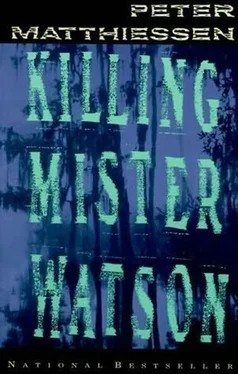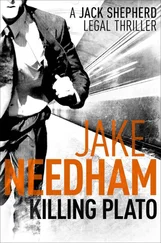Peter Matthiessen - Killing Mister Watson
Здесь есть возможность читать онлайн «Peter Matthiessen - Killing Mister Watson» весь текст электронной книги совершенно бесплатно (целиком полную версию без сокращений). В некоторых случаях можно слушать аудио, скачать через торрент в формате fb2 и присутствует краткое содержание. Жанр: Современная проза, на английском языке. Описание произведения, (предисловие) а так же отзывы посетителей доступны на портале библиотеки ЛибКат.
- Название:Killing Mister Watson
- Автор:
- Жанр:
- Год:неизвестен
- ISBN:нет данных
- Рейтинг книги:4 / 5. Голосов: 1
-
Избранное:Добавить в избранное
- Отзывы:
-
Ваша оценка:
- 80
- 1
- 2
- 3
- 4
- 5
Killing Mister Watson: краткое содержание, описание и аннотация
Предлагаем к чтению аннотацию, описание, краткое содержание или предисловие (зависит от того, что написал сам автор книги «Killing Mister Watson»). Если вы не нашли необходимую информацию о книге — напишите в комментариях, мы постараемся отыскать её.
Killing Mister Watson — читать онлайн бесплатно полную книгу (весь текст) целиком
Ниже представлен текст книги, разбитый по страницам. Система сохранения места последней прочитанной страницы, позволяет с удобством читать онлайн бесплатно книгу «Killing Mister Watson», без необходимости каждый раз заново искать на чём Вы остановились. Поставьте закладку, и сможете в любой момент перейти на страницу, на которой закончили чтение.
Интервал:
Закладка:
Mr. Dimock wrote up his adventures in a famous book called Florida Enchantments. That Yankee must of got delirious, too many skeeter bites or something, to be enchanted by these godforsaken swamps. Well, we was partial to 'em, too, never knowed why. He sent me the book, and I got my intended, young Miss Nettie Howell, to read it out to me. There was a picture of a sawfish guide in there, kind of murky but it might been me.
After I quit Mr. Dimock, the feller who took my place got pulled overboard by a sawfish, split his guts out, died before he'd figured out his own mistake. Man from the east coast, y'know. Wasn't familiar with the way we done things in the Islands.
Nine years after Mr. Watson's death, an article in the Home and Farm, published in Louisville, extolling the wonderful sport fishing out of Chokoloskee, was still warning its readers to avoid a very dangerous islander named Watson. The charge of multiple murders in the swamps (and at Key West) would be repeated many times, with varying degrees of exaggeration and pure fantasy. But in every case, as the Dimocks acknowledged, positive proof was lacking, and this is true in regard not only to Mr. Watson's guilt but to the numbers of killings that actually occurred.
In a day when Negroes were discounted, it is scarcely surprising that not one of the names of his alleged black victims has been recorded. On the other hand, some supposed white victims are also nameless, leading one to suspect that their numbers are exaggerated. Indeed, the only ones identified by his neighbors during his sojourn in the Ten Thousand Islands were old Jean Chevelier and the two Tuckers, and the first seems problematical, at best. Local people assert that Mr. Watson murdered "the old Frenchman," but when questioned closely, none of them seemed to believe it, least of all the Hamilton clan, which was close to Chevelier as well as Watson.
In their native courtesy and hospitality, one's informants imagine that the most sensational interpretation of the Watson legend is the one that the visitor wishes to hear, and one may suppose that this was true in the Dimocks' day as well. Not that the Dimocks were naïve; they had traveled widely in south Florida over many years, they knew the country and its people as well as might be expected of Yankees and outsiders, and they took an ironical view of all they saw. Nonetheless, the Watson legend may be counted among their Florida enchantments.
The most lurid view of Mr. Watson is the one often perpetuated by the islanders themselves, for as Dickens remarked after his visit to this country, "These Americans do love a scoundrel." Over long decades in lonely remote islands, where notable citizens have been few, Mr. Watson's venerable contemporaries and their descendants have arrived at an "ornery" sort of reverence for E.J. Watson, who has transcended his original role as a notorious cold-blooded killer to become a colorful folk hero, the west coast counterpart of the bank robber and killer John Ashley, whose gang terrorized eastern Florida after World War I.
Mr. Watson is considerably more intriguing than John Ashley, who was, in the end, a very ordinary sort of outlaw. By all accounts, Edgar Watson was a good husband and a loving father, an expert and dedicated farmer, successful businessman, and generous neighbor. Such virtues-not usually associated with notorious killers of the common type, who tend to be stunted and uninteresting in their social relations as well as in outlook and mentality-command our attention and explain why Mr. Watson is so fascinating, not only to the Dimocks and later writers but increasingly-dare I admit this?-to the undersigned. As a professional historian, I had thought myself beyond such subjectivity, yet the enigma of our subject's character grows rather than lessens with each new fact unearthed, however much the vulgar legend is deflated. How else to explain that, seven decades after his death, Ed Watson remains the most celebrated citizen the southwest coast of Florida ever produced?
Of the "seven mysterious murders" cited by the Dimocks, we are left with the suspicious deaths of "Tucker and his nephew," as these victims are usually described by local people. The precise identities of the Tuckers remain vague, together with the circumstances. According to the Hamilton family, who were the Tuckers' neighbors and friends, they were Walter Tucker and his wife Elizabeth, known as Wally and Bet. Despite friendship with Watson, the Hamiltons assume that he killed these young newcomers from Key West, which he himself appears to have confirmed by his hasty departure from the region.
Thus only two out of these seven unsolved killings may safely be laid at Mr. Watson's door, and probably this is a fair ratio of truth to legend when considering his lifelong career. The highest figure I have come upon is fifty-seven-Mr. Watson's own figure, it is said, as recorded in a notebook allegedly once seen by his son Lucius, who later described it to my informant, Mr. Buddy Roberts of Homestead. (Mr. Roberts's uncle Gene was a friend of Mr. Watson, and the whole family was involved in the Guy Bradley case.) There are many good reasons for doubting this story, among them Lucius Watson's well-known reluctance to discuss his father. Yet Sarah Hamilton recalled, quite separately, not only that Mr. Watson kept a journal but that it was entitled "Footnotes to My Life." And Buddy Roberts mentions a detail that could only have been known by someone close to the family, to wit, that Lucius's father had a tiny foot, and wore a size seven shoe.
There is a widespread local rumor that Mr. Watson forced one of his sons to assist him in the Tucker killings, ordering him to pursue and kill the Tucker "nephew," who fled down the beach. If such an episode took place, the victim must have been Bet Tucker and the accomplice was Rob Watson, since in 1901 young Eddie and Lucius were living with the family in Fort Myers.
Shortly after the Tucker deaths, it is related, Rob Watson fled in his father's schooner to Key West, where he sold the ship in order to finance his ongoing flight and final disappearance. Mr. Watson pursued him to Key West and, failing to find him, assaulted one Collins, who seems to have abetted young Rob's flight. Shortly thereafter, Mr. Watson himself departed southwest Florida, not to return for several years. A letter of unknown provenance written to the Smallwoods in 1904, mentioning that "friend Watson" has been in touch with the Lee County surveyor, Joseph Shands, is the first indication known to me of his return into the region.
FRANK B. TIPPINS
I heard tell of E.J. Watson long before his family came to live here. I was born in Arcadia and was back there on a cattle drive at the time of the De Soto County range wars in the early nineties. One day a local gunslinger was killed in a saloon brawl by a stranger. Quinn Bass was a local boy from the large cattle clan on the Kissimmee River, and the hired guns Quinn rode with led a crowd of rowdies and Bass relatives to storm the new jailhouse and lynch "the stranger"-more in the spirit of hell-raising than justice, since even his partners never denied that ol' Quinn asked for what it turned out he had coming. The mob was slowed by the new bricks and brave demeanor of De Soto County sheriff Ollie H. Dishong, who smiled and waved from the second story as if he was up there running for reelection. But he wasn't calm inside, he told me, because as that moonless night went on, the crowd grew so unruly that Sheriff Ollie came to doubt he could save his prisoner to go to trial. However, he reckoned that, no matter what befell this Watson, no great injustice would be done, and rather than see his brand-new jail torn up, he unlocked the cell and told the prisoner he might as well get going "while the going's good."
Читать дальшеИнтервал:
Закладка:
Похожие книги на «Killing Mister Watson»
Представляем Вашему вниманию похожие книги на «Killing Mister Watson» списком для выбора. Мы отобрали схожую по названию и смыслу литературу в надежде предоставить читателям больше вариантов отыскать новые, интересные, ещё непрочитанные произведения.
Обсуждение, отзывы о книге «Killing Mister Watson» и просто собственные мнения читателей. Оставьте ваши комментарии, напишите, что Вы думаете о произведении, его смысле или главных героях. Укажите что конкретно понравилось, а что нет, и почему Вы так считаете.












